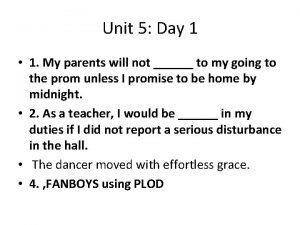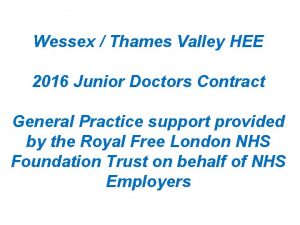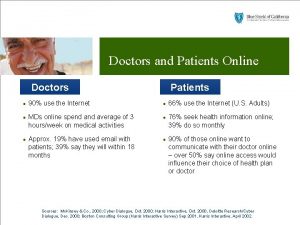Junior doctors contract The new 2016 contract Junior

















- Slides: 17

Junior doctors’ contract The new 2016 contract Junior Doctors’ Final Contract For distribution to boards, directors of medical education and medical staffing leads

Junior doctors’ contract The new 2016 contract Why do we need change? § A new contract needs to be introduced that is safe, fair and effective for both doctors and employers. § The current contract has significant weaknesses : q safety: does not support safe working practices q training: does not support the educational and training needs of doctors q pay: has perverse incentives that do not recognise or effectively reward hours being worked or the intensity of work being done.

Junior doctors’ contract The new 2016 contract Key features of the new contract Safeguards • Appointment of Guardian of Safe Working to oversee robust work schedule review process and address concerns relating to hours worked and access to training opportunities. • Safe care for patients through protection and prevention measures to stop doctors working excessive hours • New system of financial penalties to be applied where doctors are working excessive hours Training • New terms to support training and education include: ensuring proper notice of deployment to rotational placements; exception reporting applying to missed educational opportunities; and a review of access to more flexible training

Junior doctors’ contract The new 2016 contract Key features of the new contract Pay • Cost neutral – not looking to save money from new contract reforms • Pay for doctors and employers more stable and predictable; better financial management for employers • Pay progression linked to responsibility and point of training – no longer time served • Reward targeted at doctors working onerous rotas and unsocial hours; supports staff deployment to meet needs of patients on evenings and weekends (including those who work most Saturdays)

Junior doctors’ contract The new 2016 contract Safety: Restrictions on excessive hours Current contract: November offer: Final contract: Twice-yearly hours monitoring exercises Exception reports to replace hours monitoring Individual work scheduling Departmental rota Work schedule reviews on request Rigid on-call rules with limited flexibility More flexible on-call arrangements linked to intensity or work Rigid paid rest break requirements Paid 30 minute rest breaks at intervals in line with working time regulations Work schedules for GP trainees in practices to reflect COGPED guidance on work plans Work schedule reviews on request and when required by the guardian Limits on on-call working: No more than three rostered on-calls in seven days except by agreement Guaranteed rest arrangements where overnight rest is disturbed Paid rest breaks: 30 minutes if shift exceeds 5 hours, 2 x 30 minutes if shift exceeds 9 hours, taken flexibly across the shift Best practice guidance on rostering Financial penalty levied on employer for breaches of WTR 48 -hour average working hours or contractual 72 hour weekly limit.

Junior doctors’ contract The new 2016 contract Safety: Restrictions on excessive hours Current contract: November offer: Final contract: Maximum average 56 hour working week Maximum average 48 hour working week Opt out capped at maximum average of 56 working hours per week Maximum 91 hours’ work in any seven day period Maximum 72 hours’ work in any seven day period Maximum shift length of 14 hours Maximum shift length of 13 hours Maximum of 7 consecutive long shifts Maximum of 5 consecutive long shifts Maximum of 7 consecutive night shifts Maximum of 4 consecutive night shifts Minimum 11 hours rest after final night shift Minimum 48 hours rest after a run of either 3 or 4 consecutive night shifts

Junior doctors’ contract The new 2016 contract Safety: Restrictions on excessive hours Current contract: November offer: Final contract: Maximum of 12 consecutive long, late Maximum of 5 consecutive long, late evening (twilight into night) shifts Maximum of 4 consecutive long, late evening (twilight into night) shifts Minimum 11 hours rest after final long, late evening (twilight into night) shift Maximum 12 consecutive shifts Minimum 48 hours rest after 4 consecutive long, late evening (twilight into night) shifts Maximum 8 consecutive shifts 48 hours’ rest after 12 consecutive shifts 48 hours’ rest after 8 consecutive shifts

Junior doctors’ contract The new 2016 contract Training: November offer: Final contract: Work schedule to be linked to the educational curriculum Training needs to be identified and included in the work schedule HEE commitment to performance manage deaneries against code of practice on notice of deployment HEE to establish benchmark standards for educational facilities Contract will facilitate both “standard” and lead employer models HEE commitment to identify ways of reducing the costs of training through centralised provision and other means Improved access to less than full time training Enhanced continuity of service provisions to ensure that trainees returning from OOP are not unfairly deprived of occupational maternity pay Fixed leave to be replaced by a mutual obligation for employers and doctors to appropriately manage leave arrangements

Junior doctors’ contract The new 2016 contract Pay: Base pay - old and new

Junior doctors’ contract The new 2016 contract Pay: Why five nodal points? • • Informed by clinical and educational input. • Clear change in responsibility between F 1 (provisionally registered) and F 2 (fully registered). • Clear change in responsibility when moving from the Foundation Programme to Specialty Training (core or runthrough), following a competitive recruitment process before being appointed. • The first two years of Specialty (ST)/Core Training (CT) are similar in the degree of responsibility required of the trainee, and are therefore grouped into one node. There are two further nodal points at ST 3 • -7 and ST 8, reflecting the sub-specialised nature of work at ST 8. Proposed by BMA in negotiations. • This allows for a flatter pay structure minimising the impact on those on academic pathways or taking a break from training. • Accordingly, we agreed with the BMA for this option as being the one that best suited the majority of training programmes.

Junior doctors’ contract The new 2016 contract Pay: Unsocial hours enhancements • 9 pm to 7 am every day of the week – 50 per cent pay enhancement • Saturday 5 pm to 9 pm and Sunday 7 am to 9 pm – 30 per cent pay enhancement • Trainees who work shifts beginning on Saturdays 1: 4 weeks or more frequently will additionally receive a 30 per cent pay enhancements for any work done on Saturday 7 am-5 pm

Junior doctors’ contract The new 2016 contract Pay: On-call availability allowance • On-call availability allowance is a percentage of basic pay for being on call when not at work. Hours actually worked will be included in the work schedule and paid at the normal basic rate plus any enhancements applicable. Frequency required to be on-call Rate paid 1 in 4 or more frequently 10 per cent Less frequently than 1: 4 5 per cent

Junior doctors’ contract The new 2016 contract Pay: FPP Indicative Values November offer Academia 1 £ 3, 125 Emergency medicine training programmes at ST 4 and above Final contract Academia £ 4, 000 Emergency medicine training programmes at ST 4 and above £ 1, 500 General practice 2 £ 8, 200 General practice £ 8, 200 Oral and Maxillofacial Surgery Psychiatry training programmes at ST 1 and above £ 1, 500

Junior doctors’ contract The new 2016 contract Pay: Locums • Junior Doctors who opt out of the working time regulations will be required to offer ‘first refusal’ to employer for any additional shifts they may wish to work. • This work would be done via the host organisation’s / employer’s locum bank, rather than via an agency. • This work is to be paid as per national terms and conditions, set out in the pay circular each year.

Junior doctors’ contract The new 2016 contract Implementation timetable Date Grade(s) Aug-16 F 1 ST 1/2/3 All Sept ST 1+ Rotation(s) / Training programmes All GP trainees undertaking practice placements Psychiatry; Public Health Paediatrics (Core, higher and all sub-specialties) ; dentists Oct CT 1 -3 /ST 3+ All surgical specialties (including orthodontics) Nov Dec Jan-17 Feb ST 3+ ST 1 -2 Anaesthetics / ITU / Emergency Medicine / Obstetrics and Gynaecology Core Medical Training /remaining Core Surgical Training / ACCS / Anaesthetics Mar ST 3+ Any remaining Paediatrics trainees Apr ST 3+ May Any remaining surgical and all higher medical specialties Jun Aug-17 Any trainees not already included above Note: Any trainee (e. g. F 2; GP trainee in a hospital setting) sharing a rota with the above will move to the new contractual (and where applicable, pay protection) arrangements at the same time as those trainees.

Junior doctors’ contract The new 2016 contract Summary: Safer care for patients and a fair deal for doctors and employers The new contract will: • support the delivery of safer care to patients – achieved through the provision of a new and comprehensive package to address concerns raised by doctors, with additional safeguards and restrictions on the hours that doctors are required to work • include new contractual terms and additional pledges from Health Education England that support the training needs and experience of doctors • deliver a new model for pay that is fairer, more transparent and is financially sustainable, while ensuring that the average pay across the junior doctor workforce remains unchanged. It reflects agreements reached with the BMA in the discussions held in December 2015 and January 2016.

Junior doctors’ contract The new 2016 contract Finance • The contract is cost neutral with small additional transitional cost, met from the global NHS pay budget. • The cost neutrality has been modelled at a national level and there will be different implications depending on the deployment of junior doctors. The phased implementation will allow for tracking of the additional cost or saving to your organisation. • The government agreed an increase in predictable basic pay when negotiations were approved in 2012: this does increase pension contributions for both the employer and the doctor (an advantage to the latter in a career average scheme). • NHS England NHS Improvement are sighted of these implications over the three year transitional period, and these costs must also be tracked.
 Junior doctor contract 2016
Junior doctor contract 2016 Australian curriculum framework for junior doctors
Australian curriculum framework for junior doctors Junior doctors singapore
Junior doctors singapore Ifrs 15
Ifrs 15 Contingent contract and wagering agreement
Contingent contract and wagering agreement New zealand health strategy 2016
New zealand health strategy 2016 New zealand holiday 2016
New zealand holiday 2016 James wigg practice
James wigg practice Trinity doctors
Trinity doctors Time bound promotion
Time bound promotion Barbara kresal
Barbara kresal Ptal california medical board
Ptal california medical board Doctors heaton moor
Doctors heaton moor Hasawa umbrella
Hasawa umbrella Hellenistic doctors increased their knowledge by
Hellenistic doctors increased their knowledge by Woodlane medical centre
Woodlane medical centre Doctors attributed the epidemic to the rampant
Doctors attributed the epidemic to the rampant Tomorrows doctors
Tomorrows doctors

































